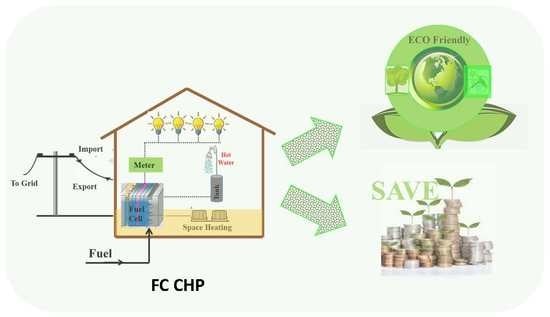Prospects of Fuel Cell Combined Heat and Power Systems
Abstract
1. Introduction
2. Fuel Cell Combined Heat and Power Systems
3. Technological Advancement for a Combined Heat and Power System
3.1. Technical Evaluation of Microgeneration and Combined Heat and Power
3.1.1. Fuel Cell Stack
3.1.2. Fuel Processor
3.1.3. Inverter/Power Electronics
3.1.4. Water Management
3.1.5. Heat Management
3.1.6. System for Delivering the Reactants
3.1.7. Afterburner/Auxiliary Burner
3.2. Summary of Merits of Fuel Cell Combined Heat and Power Systems
3.2.1. Carbon Dioxide Emission Reduction
3.2.2. Carbon Footprint for Construction
3.2.3. Decrease in Pollutant
3.2.4. Reduction of Electricity Cost
3.2.5. Grid Independence
4. Challenges Associated to Fuel Cell Combined Heat and Power Systems
5. Conclusions
Author Contributions
Funding
Conflicts of Interest
References
- Elsaid, K.; Sayed, E.T.; Abdelkareem, M.A.; Baroutaji, A.; Olabi, A.G. Environmental impact of desalination processes: Mitigation and control strategies. Sci. Total Environ. 2020, 740, 140125. [Google Scholar] [CrossRef]
- Elsaid, K.; Sayed, E.T.; Abdelkareem, M.A.; Mahmoud, M.S.; Ramadan, M.; Olabi, A.G. Environmental impact of emerging desalination technologies: A preliminary evaluation. J. Environ. Chem. Eng. 2020, 8, 104099. [Google Scholar] [CrossRef]
- Wilberforce, T.; Baroutaji, A.; Soudan, B.; Al-Alami, A.H.; Olabi, A.G. Outlook of carbon capture technology and challenges. Sci. Total Environ. 2019, 657, 56–72. [Google Scholar] [CrossRef] [PubMed]
- Singh, D.; Sharma, D.; Soni, S.; Sharma, S.; Sharma, P.K.; Jhalani, A. A review on feedstocks, production processes, and yield for different generations of biodiesel. Fuel 2020, 262, 116553. [Google Scholar] [CrossRef]
- Vakulchuk, R.; Overland, I.; Scholten, D. Renewable energy and geopolitics: A review. Renew. Sustain. Energy Rev. 2020, 122, 109547. [Google Scholar] [CrossRef]
- Seruga, P.; Krzywonos, M.; Seruga, A.; Niedźwiecki, Ł.; Pawlak-Kruczek, H.; Urbanowska, A. Anaerobic digestion performance: Separate collected vs. mechanical segregated organic fractions of municipal solid waste as feedstock. Energies 2020, 13, 3768. [Google Scholar] [CrossRef]
- Elsaid, K.; Taha Sayed, E.; Yousef, B.A.A.; Kamal Hussien Rabaia, M.; Ali Abdelkareem, M.; Olabi, A.G. Recent progress on the utilization of waste heat for desalination: A review. Energy Convers. Manag. 2020, 221, 113105. [Google Scholar] [CrossRef]
- Olabi, A.G.; Elsaid, K.; Rabaia, M.K.H.; Askalany, A.A.; Abdelkareem, M.A. Waste heat-driven desalination systems: Perspective. Energy 2020, 118373, in press. [Google Scholar] [CrossRef]
- Jouhara, H.; Olabi, A.G. Editorial: Industrial waste heat recovery. Energy 2018, 160, 1–2. [Google Scholar] [CrossRef]
- Yousef, B.A.A.; Rezk, H.; Abdelkareem, M.A.; Olabi, A.G.; Nassef, A.M. Fuzzy modeling and particle swarm optimization for determining the optimal operating parameters to enhance the bio-methanol production from sugar cane bagasse. Int. J. Energy Res. 2020. [Google Scholar] [CrossRef]
- Rezk, H.; Alsaman, A.S.; Al-Dhaifallah, M.; Askalany, A.A.; Abdelkareem, M.A.; Nassef, A.M. Identifying optimal operating conditions of solar-driven silica gel based adsorption desalination cooling system via modern optimization. Sol. Energy 2019, 181, 475–489. [Google Scholar] [CrossRef]
- Rezk, H.; Sayed, E.T.; Al-Dhaifallah, M.; Obaid, M.; El-Sayed, A.H.M.; Abdelkareem, M.A.; Olabi, A.G. Fuel cell as an effective energy storage in reverse osmosis desalination plant powered by photovoltaic system. Energy 2019, 175, 423–433. [Google Scholar] [CrossRef]
- Fathy, A.; Elaziz, M.A.; Sayed, E.T.; Olabi, A.G.; Rezk, H. Optimal parameter identification of triple-junction photovoltaic panel based on enhanced moth search algorithm. Energy 2019, 188, 116025. [Google Scholar] [CrossRef]
- Soudan, B. Community-scale baseload generation from marine energy. Energy 2019, 189, 116134. [Google Scholar] [CrossRef]
- Wilberforce, T.; El Hassan, Z.; Durrant, A.; Thompson, J.; Soudan, B.; Olabi, A.G. Overview of ocean power technology. Energy 2019, 175, 165–181. [Google Scholar] [CrossRef]
- Sayed, E.T.; Shehata, N.; Abdelkareem, M.A.; Atieh, M.A. Recent progress in environmentally friendly bio-electrochemical devices for simultaneous water desalination and wastewater treatment. Sci. Total Environ. 2020, 141046, in press. [Google Scholar] [CrossRef]
- Inayat, A.; Nassef, A.M.; Rezk, H.; Sayed, E.T.; Abdelkareem, M.A.; Olabi, A.G. Fuzzy modeling and parameters optimization for the enhancement of biodiesel production from waste frying oil over montmorillonite clay K-30. Sci. Total Environ. 2019, 666, 821–827. [Google Scholar] [CrossRef] [PubMed]
- Mahmoud, M.; Ramadan, M.; Olabi, A.-G.; Pullen, K.; Naher, S. A review of mechanical energy storage systems combined with wind and solar applications. Energy Convers. Manag. 2020, 210, 112670. [Google Scholar] [CrossRef]
- Mohamed, M.A.; Diab, A.A.Z.; Rezk, H.; Jin, T. A novel adaptive model predictive controller for load frequency control of power systems integrated with DFIG wind turbines. Neural Comput. Appl. 2020, 32, 7171–7181. [Google Scholar] [CrossRef]
- Abdelkareem, M.A.; El Haj Assad, M.; Sayed, E.T.; Soudan, B. Recent progress in the use of renewable energy sources to power water desalination plants. Desalination 2018, 435, 97–113. [Google Scholar] [CrossRef]
- Wilberforce, T.; Baroutaji, A.; El Hassan, Z.; Thompson, J.; Soudan, B.; Olabi, A.G. Prospects and challenges of concentrated solar photovoltaics and enhanced geothermal energy technologies. Sci. Total Environ. 2019, 659, 851–861. [Google Scholar] [CrossRef] [PubMed]
- Shabani, B.; Andrews, J. Standalone solar-hydrogen systems powering fire contingency networks. Int. J. Hydrog. Energy 2015, 40, 5509–5517. [Google Scholar] [CrossRef]
- Yilanci, A.; Dincer, I.; Ozturk, H.K. A review on solar-hydrogen/fuel cell hybrid energy systems for stationary applications. Prog. Energy Combust. Sci. 2009, 35, 231–244. [Google Scholar] [CrossRef]
- Maniatopoulos, P.; Andrews, J.; Shabani, B. Towards a sustainable strategy for road transportation in Australia: The potential contribution of hydrogen. Renew. Sustain. Energy Rev. 2015, 52, 24–34. [Google Scholar] [CrossRef]
- Kharel, S.; Shabani, B. Hydrogen as a long-term large-scale energy storage solution to support renewables. Energies 2018, 11, 2825. [Google Scholar] [CrossRef]
- Brandon, N.; Kurban, Z. Clean energy and the hydrogen economy. Philos. Trans. R. Soc. A Math. Phys. Eng. Sci. 2017, 375, 20160400. [Google Scholar] [CrossRef] [PubMed]
- Andrews, J.; Shabani, B. The role of hydrogen in a global sustainable energy strategy. Wiley Interdiscip. Rev. Energy Environ. 2014, 3, 474–489. [Google Scholar] [CrossRef]
- Elmer, T.; Worall, M.; Wu, S.; Riffat, S.B. Fuel cell technology for domestic built environment applications: State of-the-art review. Renew. Sustain. Energy Rev. 2015, 42, 913–931. [Google Scholar] [CrossRef]
- Ellamla, H.R.; Staffell, I.; Bujlo, P.; Pollet, B.G.; Pasupathi, S. Current status of fuel cell based combined heat and power systems for residential sector. J. Power Sources 2015, 293, 312–328. [Google Scholar] [CrossRef]
- Onovwiona, H.; Ugursal, V.I. Residential cogeneration systems: Review of the current technology. Renew. Sustain. Energy Rev. 2006, 10, 389–431. [Google Scholar] [CrossRef]
- Wilberforce, T.; El-Hassan, Z.; Khatib, F.; Al Makky, A.; Mooney, J.; Barouaji, A.; Carton, J.G.; Olabi, A.-G. Development of Bi-polar plate design of PEM fuel cell using CFD techniques. Int. J. Hydrog. Energy 2017, 42, 25663–25685. [Google Scholar] [CrossRef]
- Wilberforce, T.; Ijaodola, O.; Ogungbemi, E.; Khatib, F.; Leslie, T.; El-Hassan, Z.; Thomposon, J.; Olabi, A. Technical evaluation of proton exchange membrane (PEM) fuel cell performance–A review of the effects of bipolar plates coating. Renew. Sustain. Energy Rev. 2019, 113, 109286. [Google Scholar] [CrossRef]
- Wilberforce, T.; El Hassan, Z.; Ogungbemi, E.; Ijaodola, O.; Khatib, F.; Durrant, A.; Thompson, J.; Baroutaji, A.; Olabi, A. A comprehensive study of the effect of bipolar plate (BP) geometry design on the performance of proton exchange membrane (PEM) fuel cells. Renew. Sustain. Energy Rev. 2019, 111, 236–260. [Google Scholar] [CrossRef]
- Abdelkareem, M.A.; Sayed, E.T.; Mohamed, H.O.; Obaid, M.; Rezk, H.; Chae, K.-J. Nonprecious anodic catalysts for low-molecular-hydrocarbon fuel cells: Theoretical consideration and current progress. Prog. Energy Combust. Sci. 2020, 77, 100805. [Google Scholar] [CrossRef]
- Sayed, E.T.; Eisa, T.; Mohamed, H.O.; Abdelkareem, M.A.; Allagui, A.; Alawadhi, H.; Chae, K.-J. Direct urea fuel cells: Challenges and opportunities. J. Power Sources 2019, 417, 159–175. [Google Scholar] [CrossRef]
- Abdelkareem, M.A.; Sayed, E.T.; Alawadhi, H.; Alami, A.H. Synthesis and testing of cobalt leaf-like nanomaterials as an active catalyst for ethanol oxidation. Int. J. Hydrog. Energy 2020, 45, 17311–17319. [Google Scholar] [CrossRef]
- Ijaodola, O.; El-Hassan, Z.; Ogungbemi, E.; Khatib, F.; Wilberforce, T.; Thompson, J.; Olabi, A. Energy efficiency improvements by investigating the water flooding management on proton exchange membrane fuel cell (PEMFC). Energy 2019, 179, 246–267. [Google Scholar] [CrossRef]
- Abdelkareem, M.A.; Allagui, A.; Sayed, E.T.; El Haj Assad, M.; Said, Z.; Elsaid, K. Comparative analysis of liquid versus vapor-feed passive direct methanol fuel cells. Renew. Energy 2019, 131, 563–584. [Google Scholar] [CrossRef]
- Olabi, A.G.; Wilberforce, T.; Sayed, E.T.; Elsaid, K.; Rezk, H.; Abdelkareem, M.A. Recent progress of graphene based nanomaterials in bioelectrochemical systems. Sci. Total Environ. 2020, 141225. [Google Scholar] [CrossRef]
- Sayed, E.T.; Abdelkareem, M.A. Yeast as a biocatalyst in microbial fuel cell. Old Yeasts New Quest. Intech 2017, 41–65. [Google Scholar]
- Alami, A.H.; Abdelkareem, M.A.; Faraj, M.; Aokal, K.; Al Safarini, N. Titanium dioxide-coated nickel foam photoelectrodes for direct urea fuel cell applications. Energy 2020, 208, 118253. [Google Scholar] [CrossRef]
- Fathy, A.; Abdelkareem, M.A.; Olabi, A.G.; Rezk, H. A novel strategy based on salp swarm algorithm for extracting the maximum power of proton exchange membrane fuel cell. Int. J. Hydrog. Energy 2020, in press. [Google Scholar] [CrossRef]
- Larminie, J.; Dicks, A.; McDonald, M.S. Fuel Cell Systems Explained; J. Wiley: Chichester, UK, 2003; Volume 2. [Google Scholar]
- Wilberforce, T.; Khatib, F.; Ijaodola, O.; Ogungbemi, E.; El-Hassan, Z.; Durrant, A.; Thompson, J.; Olabi, A. Numerical modelling and CFD simulation of a polymer electrolyte membrane (PEM) fuel cell flow channel using an open pore cellular foam material. Sci. Total Environ. 2019, 678, 728–740. [Google Scholar] [CrossRef] [PubMed]
- Baroutaji, A.; Wilberforce, T.; Ramadan, M.; Olabi, A.G. Comprehensive investigation on hydrogen and fuel cell technology in the aviation and aerospace sectors. Renew. Sustain. Energy Rev. 2019, 106, 31–40. [Google Scholar] [CrossRef]
- Abdelkareem, M.A.; Sayed, E.T.; Nakagawa, N. Significance of diffusion layers on the performance of liquid and vapor feed passive direct methanol fuel cells. Energy 2020, 209, 118492. [Google Scholar] [CrossRef]
- Jiao, F.; Xu, B. Electrochemical Ammonia Synthesis and Ammonia Fuel Cells. Adv. Mater. 2019, 31, 1805173. [Google Scholar] [CrossRef]
- Boldrin, P.; Brandon, N.P. Progress and outlook for solid oxide fuel cells for transportation applications. Nat. Catal. 2019, 2, 571–577. [Google Scholar] [CrossRef]
- Rezk, H.; Nassef, A.M.; Abdelkareem, M.A.; Alami, A.H.; Fathy, A. Comparison among various energy management strategies for reducing hydrogen consumption in a hybrid fuel cell/supercapacitor/battery system. Int. J. Hydrog. Energy 2019, in press. [Google Scholar] [CrossRef]
- Ogungbemi, E.; Wilberforce, T.; Ijaodola, O.; Thompson, J.; Olabi, A. Selection of proton exchange membrane fuel cell for transportation. Int. J. Hydrog. Energy 2020, in press. [Google Scholar] [CrossRef]
- Mohideen, M.M.; Liu, Y.; Ramakrishna, S. Recent progress of carbon dots and carbon nanotubes applied in oxygen reduction reaction of fuel cell for transportation. Appl. Energy 2020, 257, 114027. [Google Scholar] [CrossRef]
- Rath, R.; Kumar, P.; Mohanty, S.; Nayak, S.K. Recent advances, unsolved deficiencies, and future perspectives of hydrogen fuel cells in transportation and portable sectors. Int. J. Energy Res. 2019, 43, 8931–8955. [Google Scholar] [CrossRef]
- Zhang, G.; Kandlikar, S.G. A critical review of cooling techniques in proton exchange membrane fuel cell stacks. Int. J. Hydrog. Energy 2012, 37, 2412–2429. [Google Scholar] [CrossRef]
- Zaman, S.F.; Jolaoso, L.A.; Podila, S.; Al-Zahrani, A.A.; Alhamed, Y.A.; Driss, H.; Daous, M.M.; Petrov, L. Ammonia decomposition over citric acid chelated g-Mo2N and Ni2Mo3N catalysts. Int. J. Hydrog. Energy 2018, 43, e17258. [Google Scholar] [CrossRef]
- Rosli, R.; Sulong, A.; Daud, W.; Zulkifley, M.; Husaini, T.; Rosli, M.; Majlan, E.; Haque, M. A review of high-temperature proton exchange membrane fuel cell (HT-PEMFC) system. Int. J. Hydrog. Energy 2017, 42, 9293–9314. [Google Scholar] [CrossRef]
- Wilberforce, T.; Ijaodola, O.; Khatib, F.; Ogungbemi, E.; El Hassan, Z.; Thompson, J.; Olabi, A. Effect of humidification of reactive gases on the performance of a proton exchange membrane fuel cell. Sci. Total Environ. 2019, 688, 1016–1035. [Google Scholar] [CrossRef] [PubMed]
- Ijaodola, O.; Ogungbemi, E.; Khatib, F.N.; Wilberforce, T.; Ramadan, M.; El Hassan, Z.; Thompson, J.; Olabi, A.G. Evaluating the effect of metal bipolar plate coating on the performance of proton exchange membrane fuel cells. Energies 2018, 11, 3203. [Google Scholar] [CrossRef]
- Wilberforce, T.; Alaswad, A.; Palumbo, A.; Dassisti, M.; Olabi, A.-G. Advances in stationary and portable fuel cell applications. Int. J. Hydrog. Energy 2016, 41, 16509–16522. [Google Scholar] [CrossRef]
- Wilberforce, T.; Ijaodola, O.; Ogungbemi, E.; El Hassan, Z.; Thompson, J.; Olabi, A.G. Effect of bipolar plate materials on performance of fuel cells. In Reference Module in Materials Science and Materials Engineering; Elsevier Inc.: Amsterdam, The Netherlands, 2018; pp. 1–15. [Google Scholar]
- Islam, M.R.; Shabani, B.; Rosengarten, G. Nanofluids to improve the performance of PEM fuel cell cooling systems: A theoretical approach. Appl. Energy 2016, 178, 660–671. [Google Scholar] [CrossRef]
- Islam, M.; Shabani, B.; Rosengarten, G.; Andrews, J. The potential of using nanofluids in PEM fuel cell cooling systems: A review. Renew. Sustain. Energy Rev. 2015, 48, 523–539. [Google Scholar] [CrossRef]
- Wilberforce, T.; El-Hassan, Z.; Khatib, F.; Al Makky, A.; Baroutaji, A.; Carton, J.G.; Olabi, A.G. Developments of electric cars and fuel cell hydrogen electric cars. Int. J. Hydrog. Energy 2017, 42, 25695–25734. [Google Scholar] [CrossRef]
- Wilberforce, T.; El-Hassan, Z.; Khatib, F.; Al Makky, A.; Baroutaji, A.; Carton, J.G.; Thompson, J.; Olabi, A.G. Modelling and simulation of Proton Exchange Membrane fuel cell with serpentine bipolar plate using MATLAB. Int. J. Hydrog. Energy 2017, 42, 25639–25662. [Google Scholar] [CrossRef]
- Omrani, R.; Shabani, B. Gas diffusion layer modifications and treatments for improving the performance of proton exchange membrane fuel cells and electrolysers: A review. Int. J. Hydrog. Energy 2017, 42, 28515–28536. [Google Scholar] [CrossRef]
- Li, H.; Tang, Y.; Wang, Z.; Shi, Z.; Wu, S.; Song, D.; Zhang, J.; Fatih, K.; Zhang, J.; Wang, H. A review of water flooding issues in the proton exchange membrane fuel cell. J. Power Sources 2008, 178, 103–117. [Google Scholar] [CrossRef]
- Hwang, J.J.; Zou, M.L.; Chang, W.R.; Su, A.; Weng, F.B.; Wu, W. Implementation of a heat recovery unit in a proton exchange membrane fuel cell system. Int. J. Hydrog. Energy 2010, 35, 8644–8653. [Google Scholar] [CrossRef]
- Briguglio, N.; Ferraro, M.; Brunaccini, G.; Antonucci, V. Evaluation of a low temperature fuel cell system for residential CHP. Int. J. Hydrog. Energy 2011, 36, 8023–8029. [Google Scholar] [CrossRef]
- Gigliucci, G.; Petruzzi, L.; Cerelli, E.; Garzisi, A.; La Mendola, A. Demonstration of a residential CHP system based on PEM fuel cells. J. Power Sources 2004, 131, 62–68. [Google Scholar] [CrossRef]
- Shabani, B.; Andrews, J. An experimental investigation of a PEM fuel cell to supply both heat and power in a solar-hydrogen RAPS system. Int. J. Hydrog. Energy 2011, 36, 5442–5452. [Google Scholar] [CrossRef]
- Oh, S.-D.; Kim, K.-Y.; Oh, S.-B.; Kwak, H.-Y. Optimal operation of a 1-kW PEMFC-based CHP system for residential applications. Appl. Energy 2012, 95, 93–101. [Google Scholar] [CrossRef]
- Gandiglio, M.; Lanzini, A.; Santarelli, M.; Leone, P. Design and optimization of a proton exchange membrane fuel cell CHP system for residential use. Energy Build. 2014, 69, 381–393. [Google Scholar] [CrossRef]
- Barelli, L.; Bidini, G.; Gallorini, F.; Ottaviano, A. An energetic–exergetic comparison between PEMFC and SOFC-based micro-CHP systems. Int. J. Hydrog. Energy 2011, 36, 3206–3214. [Google Scholar] [CrossRef]
- Aleknaviciute, I.; Karayiannis, T.; Collins, M.; Xanthos, C. Towards clean and sustainable distributed energy system: The potential of integrated PEMFC-CHP. Int. J. Low Carbon Technol. 2016, 11, 296–304. [Google Scholar] [CrossRef]
- OH, S.T.; Saha, B.B.; Kariya, K.; Hamamoto, Y.; Mori, H. Fuel cell waste heat powered adsorption cooling systems. Int. J. Air Cond. Refrig. 2013, 21, 1350010. [Google Scholar] [CrossRef]
- He, T.; Shi, R.; Peng, J.; Zhuge, W.; Zhang, Y. Waste heat recovery of a PEMFC system by using organic rankine cycle. Energies 2016, 9, 267. [Google Scholar] [CrossRef]
- Lee, W.-Y.; Kim, M.; Sohn, Y.-J.; Kim, S.-G. Power optimization of a combined power system consisting of a high-temperature polymer electrolyte fuel cell and an organic Rankine cycle system. Energy 2016, 113, 1062–1070. [Google Scholar] [CrossRef]
- Hasani, M.; Rahbar, N. Application of thermoelectric cooler as a power generator in waste heat recovery from a PEM fuel cell–an experimental study. Int. J. Hydrog. Energy 2015, 40, 15040–15051. [Google Scholar] [CrossRef]
- Tetuko, A.P.; Shabani, B.; Andrews, J. Thermal coupling of PEM fuel cell and metal hydride hydrogen storage using heat pipes. Int. J. Hydrog. Energy 2016, 41, 4264–4277. [Google Scholar] [CrossRef]
- Tetuko, A.; Shabani, B.; Andrews, J. Passive fuel cell heat recovery using heat pipes to enhance metal hydride canisters hydrogen discharge rate: An experimental simulation. Energies 2018, 11, 915. [Google Scholar] [CrossRef]
- Reddy, E.H.; Jayanti, S. Thermal coupling studies of a high temperature proton exchange membrane fuel cell stack and a metal hydride hydrogen storage system. Energy Procedia 2012, 29, 254–264. [Google Scholar] [CrossRef]
- Mohamed, W.; Kamil, M.H.M. Hydrogen preheating through waste heat recovery of an open-cathode PEM fuel cell leading to power output improvement. Energy Convers. Manag. 2016, 124, 543–555. [Google Scholar] [CrossRef]
- Ganapathy, V. Industrial Boilers and Heat Recovery Steam Generators: Design, Applications, and Calculations; CRC Press: Boca Raton, FL, USA, 2002. [Google Scholar]
- Ogungbemi, E.; Ijaodola, O.; Khatib, F.; Wilberforce, T.; El Hassan, Z.; Thompson, J.; Ramadan, M.; Olabi, A. Fuel cell membranes–Pros and cons. Energy 2019, 172, 155–172. [Google Scholar] [CrossRef]
- Wilberforce, T.; Olabi, A.G. Performance Prediction of Proton Exchange Membrane Fuel Cells (PEMFC) Using Adaptive Neuro Inference System (ANFIS). Sustainability 2020, 12, 4952. [Google Scholar] [CrossRef]
- Wilberforce, T.; Olabi, A.G. Design of Experiment (DOE) Analysis of 5-Cell Stack Fuel Cell Using Three Bipolar Plate Geometry Designs. Sustainability 2020, 12, 4488. [Google Scholar] [CrossRef]
- Abdelkareem, M.A.; Tanveer, W.H.; Sayed, E.T.; Assad, M.E.H.; Allagui, A.; Cha, S.W. On the technical challenges affecting the performance of direct internal reforming biogas solid oxide fuel cells. Renew. Sustain. Energy Rev. 2019, 101, 361–375. [Google Scholar] [CrossRef]
- Dodds, P.E.; Hawkes, A.D.; McDowall, W.; Li, F.; Staffell, I.; Grünewald, P. The Role of Hydrogen and Fuel Cells in Providing Affordable, Secure Lowcarbon Heat, H2FC SUPERGEN, London. 2014. Available online: http://goo.gl/hLJ0Rp (accessed on 17 July 2020).
- Maru, H.; Singhal, S.C.; Stone, C.; Wheeler, D. 1e10 KW Stationary Combined Heat and Power Systems Status and Technical Potential, National Renewable Energy Laboratory, USA. 2010. Available online: http://goo.gl/T6c3C0 (accessed on 17 July 2020).
- 4th Energy Wave, Fuel Cell Annual Review. 2014. Available online: http://tinyurl.com/pm5qfhw (accessed on 17 July 2020).
- Staffell, I.; Green, R. The cost of domestic fuel cell micro-CHP systems. Int. J. Hydrog. Energy 2013, 38, 1088–1102. [Google Scholar] [CrossRef]
- Dodds, P.E.; Staffell, I.; Hawkes, A.D.; Li, F.; Grünewald, P.; McDowall, W.; Ekins, P. Hydrogen and fuel cell technologies for heating: A review. Int. J. Hydrog. Energy 2015, 40, 2065–2083. [Google Scholar] [CrossRef]
- The Fuel Cell Industry Review, Fuel Cell Today. 2013. Available online: http://goo.gl/tUjvG9 (accessed on 23 March 2020).
- Country Update of Japan, Current Statusof H2 and Fuel Cell Programs of Japan, in: 20th International Partnership for Hydrogen and Fuel Cells (IPHE) Steering Committee Meeting. 2013. Available online: http://goo.gl/AaD2lb (accessed on 23 March 2020).
- Hawkes, A.; Staffell, I.; Brett, D.; Brandon, N. Fuel cells for micro-combined heat and power generation. Energy Environ. Sci. 2009, 2, 729–744. [Google Scholar] [CrossRef]
- Sauter, R.M.; Pehnt, M.; Cames, C.; Fischer, B.; Praetorius, L.; Schneider, K. Schumacher and JP Vo [ss], Editors, Micro Cogeneration. Towards Decentralized Energy Systems, Springer, Heidelberg (2006) ISBN 3-540-25582-6 (346pp., 59 illus., Hardcover, [euro] 106.95). Energy Policy 2007, 35, 2018–2020. [Google Scholar] [CrossRef]
- Carbon Trust, N. Micro-CHP Accelerator: Interim Report; Carbon Trust London: London, UK, 2007. [Google Scholar]
- Devices, R. Swift rooftop wind energy system: Technical and planning information—Rev F1. Available online: http://www.olino.org/blog/nl/wp-content/uploads/2008/articles/energyhouse-swift-technical-information-pack.pdf (accessed on 5 August 2020).
- Brett, D.J.; Brandon, N.P. Review of materials and characterization methods for polymer electrolyte fuel cell flow-field plates. J. Electrochem. En. Conv. Stor. 2007, 4, 29–44. [Google Scholar] [CrossRef]
- Baschuk, J.; Li, X. Carbon monoxide poisoning of proton exchange membrane fuel cells. Int. J. Energy Res. 2001, 25, 695–713. [Google Scholar] [CrossRef]
- Zhang, J.; Xie, Z.; Zhang, J.; Tang, Y.; Song, C.; Navessin, T.; Shi, Z.; Song, D.; Wang, H.; Wilkinson, D.P. High temperature PEM fuel cells. J. Power Sources 2006, 160, 872–891. [Google Scholar] [CrossRef]
- Tanveer, W.H.; Rezk, H.; Nassef, A.; Abdelkareem, M.A.; Kolosz, B.; Karuppasamy, K.; Aslam, J.; Gilani, S.O. Improving fuel cell performance via optimal parameters identification through fuzzy logic based-modeling and optimization. Energy 2020, 204, 117976. [Google Scholar] [CrossRef]
- Brett, D.J.; Atkinson, A.; Brandon, N.P.; Skinner, S.J. Intermediate temperature solid oxide fuel cells. Chem. Soc. Rev. 2008, 37, 1568–1578. [Google Scholar] [CrossRef] [PubMed]
- Kolb, G. Fuel Processing: For Fuel Cells; John Wiley & Sons: Hoboken, NJ, USA, 2008. [Google Scholar]
- Hubert, C.-E.; Achard, P.; Metkemeijer, R. Study of a small heat and power PEM fuel cell system generator. J. Power Sources 2006, 156, 64–70. [Google Scholar] [CrossRef]
- Lohsoontorn, P.; Brett, D.; Brandon, N. The effect of fuel composition and temperature on the interaction of H2S with nickel–ceria anodes for Solid Oxide Fuel Cells. J. Power Sources 2008, 183, 232–239. [Google Scholar] [CrossRef]
- Brett, D.; Aguiar, P.; Brandon, N.; Kucernak, A. Measurement and modelling of carbon monoxide poisoning distribution within a polymer electrolyte fuel cell. Int. J. Hydrog. Energy 2007, 32, 863–871. [Google Scholar] [CrossRef]
- Schmidt, D.S. In Status of the Acumentrics SOFC Program; Fuel Cell Seminar & Exposition: Long Beach, CA, USA, 2006. [Google Scholar]
- Colella, W. Design options for achieving a rapidly variable heat-to-power ratio in a combined heat and power (CHP) fuel cell system (FCS). J. Power Sources 2002, 106, 388–396. [Google Scholar] [CrossRef]
- IEA. Global Energy and Carbon Dioxdie Staus Report 2019. The Latest Trends in Energy and Emissions; IEA: Paris, France, 2019. [Google Scholar]
- Callux, Practical Tests for Fuel Cells in a Domestic Setting. Available online: http://www.callux.net/home.English.html (accessed on 13 July 2020).
- World Energy Outlook. Available online: http://www.callux.net/home.English.html (accessed on 13 July 2020).
- Foger, K. CFCL: Challenges in Commercialising An Ultra-Efficient SOFC Residential Generator, In: International Partnership for Hydrogen and Fuel Cells (IPHE) Workshop on Stationary Fuel Cells, Tokyo. 2011. Available online: http://tinyurl.com/82eqw7h (accessed on 25 March 2020).
- Statistical Data Set: Annual Domestic Energy Bills. UK. 2014. Available online: http://tinyurl.com/o8zybas (accessed on 14 February 2020).
- Brooks, K.; Pilli, S.; Makhmalbaf, A.; Srivastava, V.; Anderson, D.; Upton, J. Business Case for a Micro-Combined Heat and POWER FUEL-CELL SYSTEM In Commercial Applications, Pacific Northwest National Laboratory, USA. 2013. Available online: http://goo.gl/b2xX1T. (accessed on 18 July 2020).
- Staffell, I. The Energy and Fuel Data Sheet. 2011. Available online: http://goo.gl/hvByt9 (accessed on 19 July 2020).
- Hawkes, A.D. Estimating marginal CO2 emissions rates for national electricity systems. Energy Policy 2010, 38, 5977–5987. [Google Scholar] [CrossRef]
- Staffell, I. Zero carbon infinite COP heat from fuel cell CHP. Appl. Energy 2015, 147, 373–385. [Google Scholar] [CrossRef]
- Staffell, I.; Ingram, A.; Kendall, K. Energy and carbon payback times for solid oxide fuel cell based domestic CHP. Int. J. Hydrog. Energy 2012, 37, 2509–2523. [Google Scholar] [CrossRef]
- Staffell, I.; Ingram, A. Life cycle assessment of an alkaline fuel cell CHP system. Int. J. Hydrog. Energy 2010, 35, 2491–2505. [Google Scholar] [CrossRef]
- Moomaw, W.; Burgherr, P.; Heath, G.; Lenzen, M.; Nyboer, J.; Verbruggen, A. Annex II: Methodology; Edenhofer, O., Pichs-Madruga, R., Sokona, Y., Seyboth, K., Matschoss, P., Kadner, S., Eds.; IPCC Special Report on Renewable Energy Sources and Climate Change Mitigation; Cambridge University Press: Cambridge, UK, 2011. [Google Scholar]
- Carbon Footprint of Electricity Generation. London. 2011. Available online: https://www.parliament.uk/documents/post/postpn_383-carbon-footprint-electricity-generation.pdf (accessed on 18 July 2020).
- Pollutant Information: Sulphur dioxide. Available online: http://www.epa.gov/air/sulfurdioxide (accessed on 23 May 2020).
- Review of Combined Heat and Power Technologies, Department of Energy (DOE), USA. 1999. Available online: http://goo.gl/hnCNXl (accessed on 23 May 2020).
- Staffell, I.; Baker, P.; Barton, J.P.; Bergman, N.; Blanchard, R.; Brandon, N.P.; Brett, D.J.; Hawkes, A.; Infield, D.; Jardine, C.N. UK microgeneration. Part II: Technology overviews. Proc. Inst. Civ. Eng. Energy 2010, 163, 143–165. [Google Scholar] [CrossRef]
- Staffell, I. Fuel Cells for Domestic Heat and Power: Are they Worth it? University of Birmingham. 2009. Available online: http://goo.gl/JB4Yjp (accessed on 11 April 2020).
- European Energy Price Statistics. Available online: http://ec.europa.eu/eurostat (accessed on 25 May 2020).
- Greene, D.L.; Duleep, K.G.; Upreti, G. Status and Outlook for the U.S. Nonautomotive Fuel Cell Industry: Impacts of Government Policies and Assessment of Future Opportunities. 2011. Available online: http://goo.gl/bIA7GV (accessed on 30 March 2020).
- Electric Power Transmission and Distribution Losses. 2011. Available online: http://data.worldbank.org/indicator/EG.ELC.LOSS.KH (accessed on 21 May 2020).
- Chen, A. Berkeley Lab Study Estimates $80 Billion Annual Cost of Power Interruption, Berkeley lab, USA. 2005. Available online: http://goo.gl/tRVT9F (accessed on 18 June 2020).
- Patterson, T.U.S. Electricity Blackouts Skyrocketing. 2010. Available online: http://goo.gl/M7vcc2 (accessed on 21 May 2020).
- Wing, J. Handling the Cost of Residential Fuel Cells, Fuel Cell Today 2013. Available online: http://goo.gl/Py0JN4 (accessed on 20 February 2020).
- Staffell, I.; Scamman, D.; Velazquez Abad, A.; Balcombe, P.; Dodds, P.E.; Ekins, P.; Shah, N.; Ward, K.R. The role of hydrogen and fuel cells in the global energy system. Energy Environ. Sci. 2019, 12, 463–491. [Google Scholar] [CrossRef]
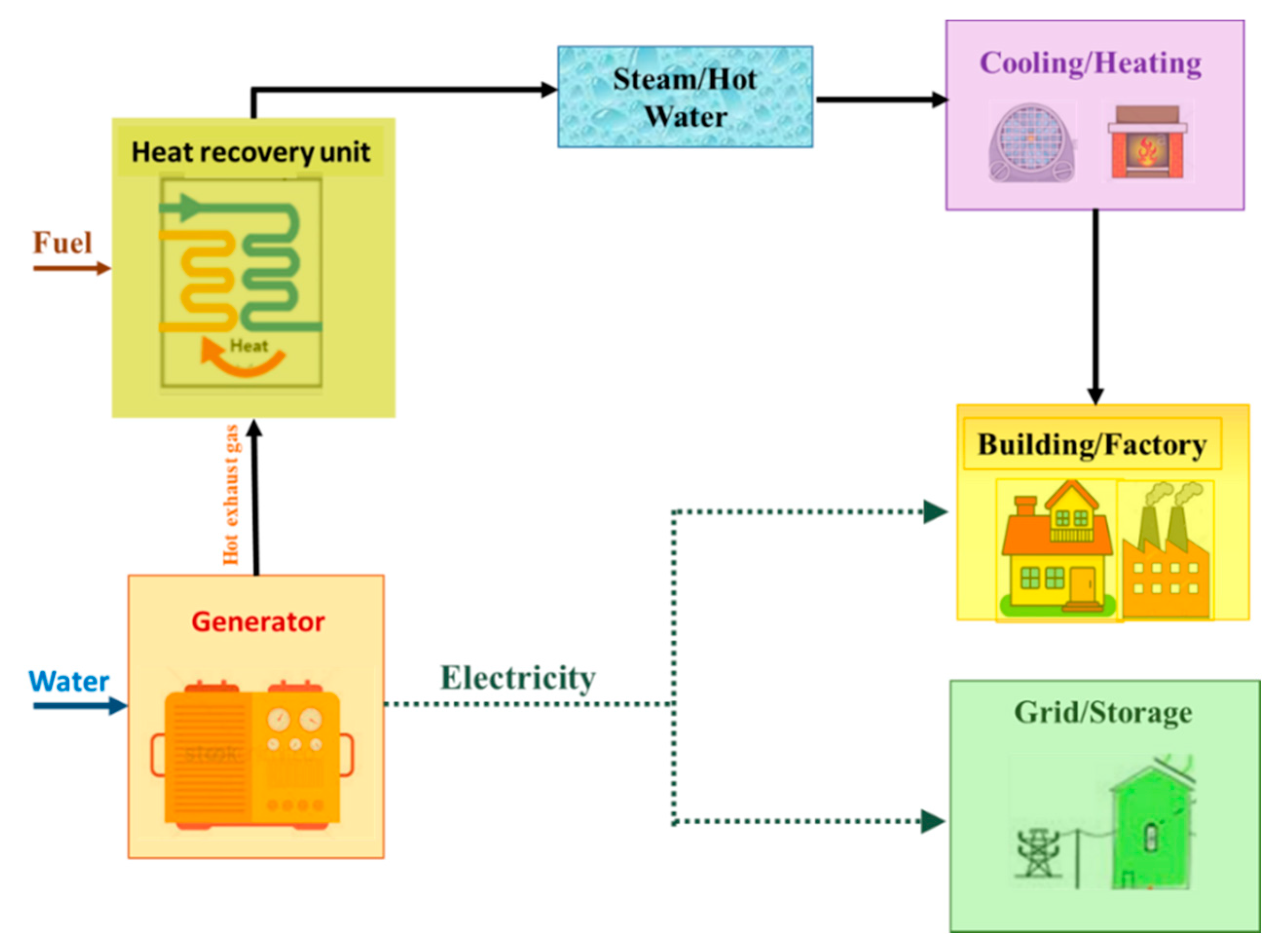

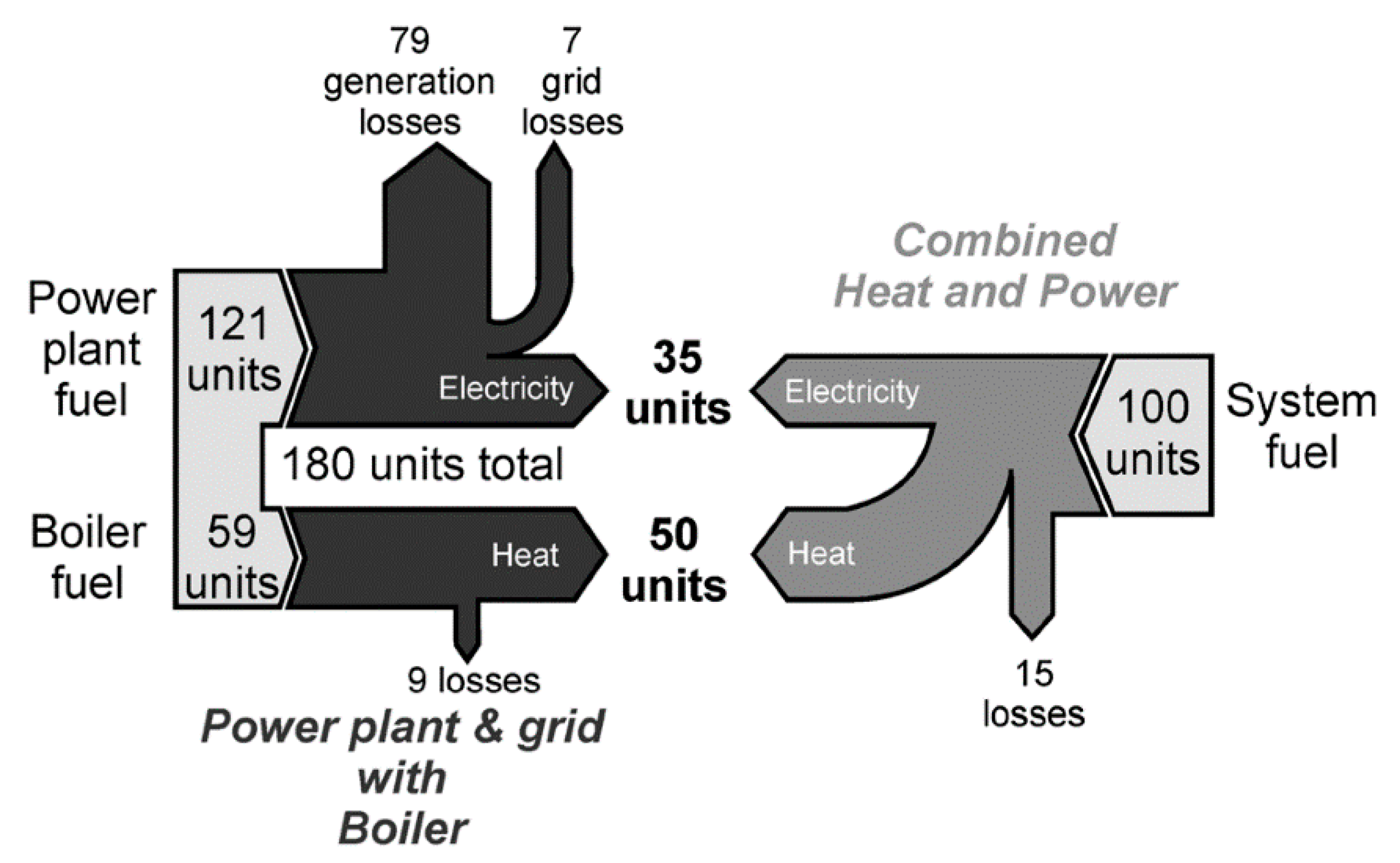
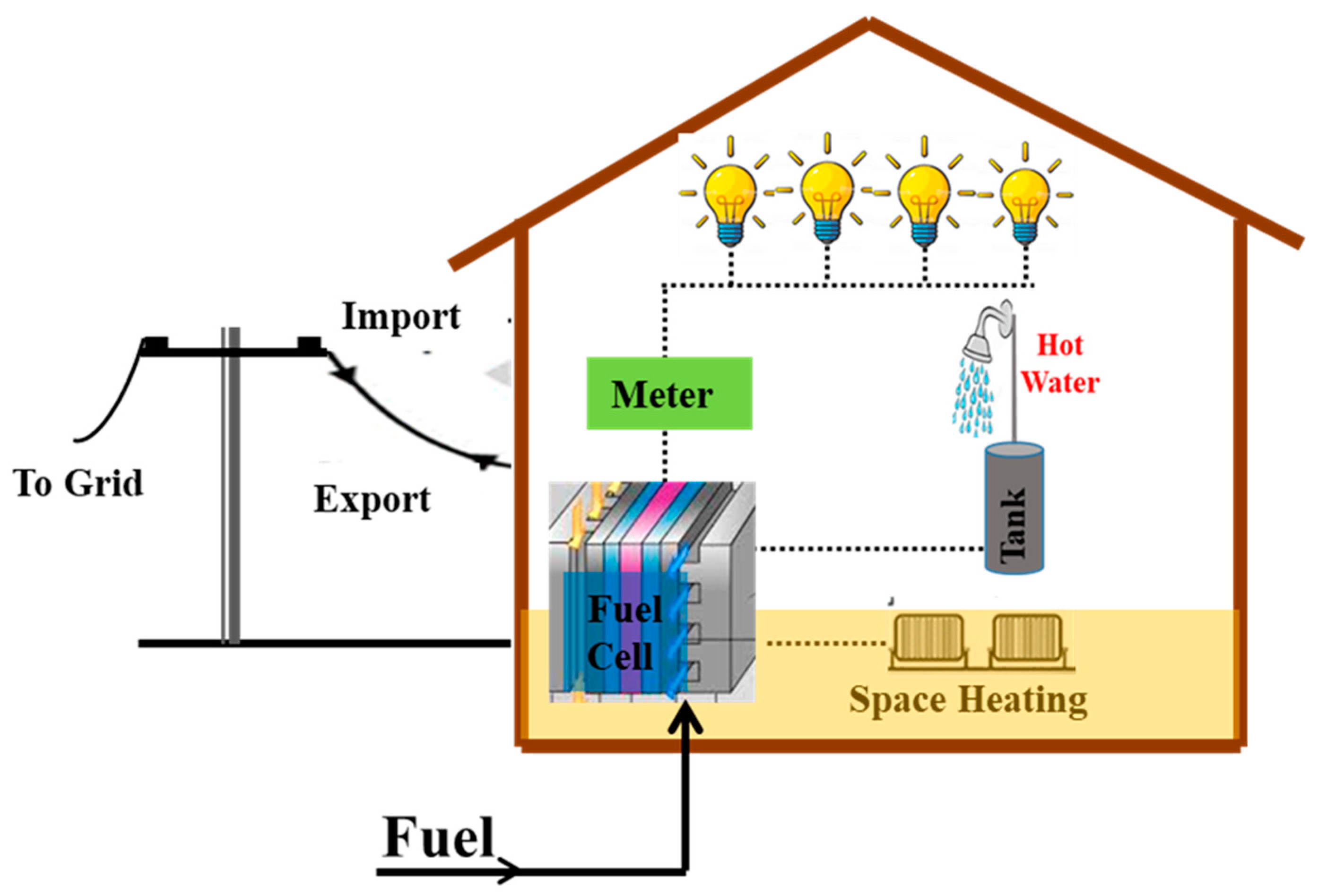
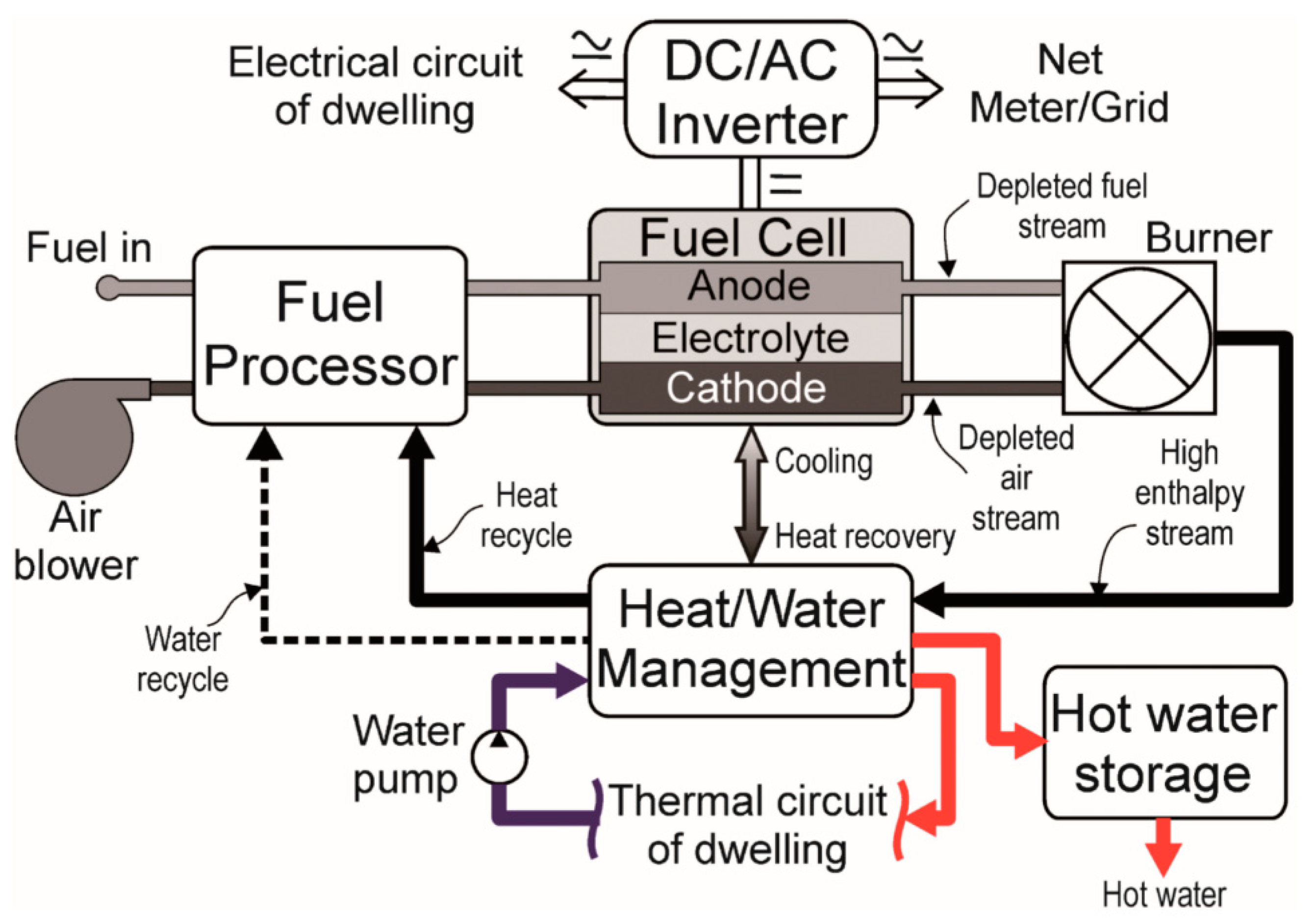


| Rating | Megawatt | Sub Megawatt-Class | Micro Combined Heat and Power | ||
|---|---|---|---|---|---|
| Category of fuel cell | MCFCs | PFCs | SOFCs | PEMFCs | SOFCs |
| Electrical capacity | 300 KW–2.8 MW | 400 kW | Up to 200 kW | Less than 10 kW | 700–1000 |
| Operational temperature | 600–700 | 160–220 | 700–1000 | 60–80 100–200 | |
| Electrolyte | Li2CO3/K2CO3 materials | H3PO4 | ZrO2 | Nafion Polybenzimidazole electrolytes | ZrO2 |
| Use | Domestic and industrial purposes | Industrial purposes | Industrial purposes | Domestic and industrial purposes | |
| Source of hydrogen | CH4 | CH4 | CH4 | CH4 | |
| Types of fuel that can be used | Hydrogen gas, methane | Hydrogen gas | Hydrogen gas, methane | Hydrogen gas, methanol | Hydrogen gas, methane |
| Source of oxygen | Pure oxygen gas and air | Pure oxygen gas and air | Pure oxygen gas and air | Pure oxygen gas and air | |
| Merits | Higher performance can be scaled down, and varying fuel cells are applicable | cogeneration performance is high | Cell performance is high | Higher performance | |
| Power performance (%) | 42–48 | 40–43 | 50–65 | 21–40 | 40–60 |
| Combine heat and power performance (%) | 85 | 85–90 | 90 | 87–90 (low temperature fuel cells) 85–90 (high temperature fuel cell) | 90 |
| Combine heat and power applications | Space heating and heating water | heating water | Subject to the technology adopted | Suitable for space heating | |
| Possible pollutant | Sulfur | Carbon monoxide is less than 1% | Sulfur | Carbon monoxide is less than 10 part per million (low-temperature fuel cell). Carbon monoxide is less than 5 ppm, and only traces of sulfur and ammonia are detected (High-temperature PEMFC). | Sulfur |
| Production Company | Name of Product | Category of Cell Used | Power Generated (W) |
|---|---|---|---|
| Ceramic fuel cells | BlueGen | Solid oxide fuel cell | 1500 |
| Panasonic | ENE-FARM | PEMFCs operated at lower temperatures | 250–750 |
| Toshiba | ENE-FARM | PEMFCs operated at lower temperatures | 250–700 |
| EneosCellTech | ENE-FARM | PEMFCs operated at lower temperatures | 250–700 |
| Kyocera | ENE-FARM | SOFCs | 200–700 |
| Aisin Seiki | ENE-FARM | SOFCs | 200–700 |
| JxEneos | ENE-FARM | SOFCs | 250–700 |
| Fuel Cells | Condensing Boiler | Combine Heat and Power Engines | |
|---|---|---|---|
| Nitrous oxide | 1–4 | 58 | 30–270 |
| Carbon monoxide | 1–8 | 43 | 10–50 |
| Methane | 1–3 | 13 | |
| Sulphur dioxide | 0–2 | 2 |
| Power Failure | Time | Time Facility Stopped | Failure Numbers in the Year | Interruptions Created Yearly | Price Estimate US$ | Annual Estimate US$ |
|---|---|---|---|---|---|---|
| Brief interruptions | 5.3 s | 15 min | 5 | 1 h | 4000 | 4000 |
| Extensive time interruption | 1 h | 2 h | 1 | 2 h | 4000 | 8000 |
| Total | 5 | 3 h | 12,000 |
© 2020 by the authors. Licensee MDPI, Basel, Switzerland. This article is an open access article distributed under the terms and conditions of the Creative Commons Attribution (CC BY) license (http://creativecommons.org/licenses/by/4.0/).
Share and Cite
Olabi, A.G.; Wilberforce, T.; Sayed, E.T.; Elsaid, K.; Abdelkareem, M.A. Prospects of Fuel Cell Combined Heat and Power Systems. Energies 2020, 13, 4104. https://doi.org/10.3390/en13164104
Olabi AG, Wilberforce T, Sayed ET, Elsaid K, Abdelkareem MA. Prospects of Fuel Cell Combined Heat and Power Systems. Energies. 2020; 13(16):4104. https://doi.org/10.3390/en13164104
Chicago/Turabian StyleOlabi, A.G., Tabbi Wilberforce, Enas Taha Sayed, Khaled Elsaid, and Mohammad Ali Abdelkareem. 2020. "Prospects of Fuel Cell Combined Heat and Power Systems" Energies 13, no. 16: 4104. https://doi.org/10.3390/en13164104
APA StyleOlabi, A. G., Wilberforce, T., Sayed, E. T., Elsaid, K., & Abdelkareem, M. A. (2020). Prospects of Fuel Cell Combined Heat and Power Systems. Energies, 13(16), 4104. https://doi.org/10.3390/en13164104






